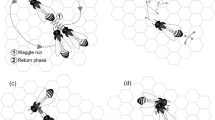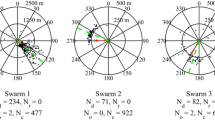Abstract
A swarm of honeybees provides a striking example of an animal group performing a synchronized departure for a new location; in this case, thousands of bees taking off at once to fly to a new home. However, the means by which this is achieved remain unclear. Shortly before takeoff, one hears a crescendo of a high-pitched mechanical signal—worker piping—so we explored the role of this signal in coordinating a swarm’s mass takeoff. Specifically, we examined whether exclusively nest site scouts produce the worker piping signal or whether it is produced in a relay or chain reaction fashion. We found no evidence that bees other than the scouts that have visited the swarm’s chosen nest site produce piping signals. This absence of relay communication in piping suggests that it is a signal that only primes swarms for takeoff and that the release of takeoff is triggered by some other signal or cue; perhaps the takeoff of bees on the swarm periphery as they reach flight temperature in response to piping.

Similar content being viewed by others
References
Black JM (1988) Preflight signalling in swans: a mechanism for group cohesion and flock formation. Ethology 79:143–157
Camazine S, Visscher PK, Finley J, Vetter RS (1999) House-hunting by honey bee swarms: collective decisions and individual behaviors. Insectes Soc 46:348–360
Camazine S, Deneubourg JL, Franks NR, Sneyd J, Theraulaz G, Bonabeau E (2001) Self-organization in biological systems. Princeton University Press, Princeton, NJ
Conradt L, Roper TJ (2003) Group decision-making in animals. Nature 421:155–158
Donahoe K, Lewis LA, Schneider SS (2003) The role of the vibration signal in the house-hunting process of honey bee (Apis mellifera) swarms. Behav Ecol Sociobiol 54:593–600
Dyer FC (2000) Group movement and individual cognition: lessons from social insects. In: Boinski S, Garber PA (eds) On the move: how and why animals travel in groups. University of Chicago Press, Chicago, IL
Kummer H (1968) Social organization of hamadryas baboons. University of Chicago Press, Chicago, IL
Lindauer M (1955) Schwarmbienen auf Wohnungssuche. Z Vgl Physiol 37:263–324
Poole JH, Payne K, Langbauer WR, Moss CJ (1988) The social contexts of some very low frequency calls of African elephants. Behav Ecol Sociobiol 22:385–392
Pratt SC, Mallon EB, Sumpter DJT, Franks NR (2002) Quorum sensing, recruitment, and collective decision-making during colony emigration by the ant Leptothorax albipennis. Behav Ecol Sociobiol 52:117–127
Seeley TD (1995) The wisdom of the hive: the social physiology of honey bee colonies. Harvard University Press, Cambridge, MA
Seeley TD, Buhrman SC (1999) Group decision making in swarms of honey bees. Behav Ecol Sociobiol 45:19–31
Seeley TD, Morse RA (1978) Nest site selection by the honey bee, Apis mellifera. Insectes Soc 25:323–337
Seeley TD, Tautz J (2001) Worker piping in honey bee swarms and its role in preparing for liftoff. J Comp Physiol A 187:667–676
Seeley TD, Visscher PK (2003) Choosing a home: how the scouts in a honey bee swarm perceive the completion of their group decision making. Behav Ecol Sociobiol 54:511–520
Seeley TD, Visscher PK (2004) Quorum sensing during nest-site selection by honeybee swarms. Behav Ecol Sociobiol 56:594–601
Seeley TD, Kleinhenz M, Bujok B, Tautz J (2003) Thorough warm-up before take-off in honey bee swarms. Naturwissenschaften 90:256–260
Stewart KJ, Harcourt AH (1994) Gorillas’ vocalizations during rest periods: signals of impending departure? Behaviour 130:29–40
Visscher PK (2007) Group decision making in nest site selection among social insects. Annu Rev Entomol 52:255–295
von Frisch K (1967) The dance language and orientation of bees. Harvard University Press, Cambridge, MA
Wilson EO (1971) The insect societies. Harvard University Press, Cambridge, MA
Acknowledgements
We are grateful to Kevin Passino and Ariel Zimmerman for their assistance in marking the scout bees at the nest box. This study was supported by the US National Science Foundation (grant no. IBN02-10541 to TDS) and by the US Department of Agriculture (CSREES CA-R-ENT-6892 to PKV). The staff of the Shoals Marine Laboratory of Cornell University and the University of New Hampshire, as usual, made it a pleasure to work on Appledore Island.
Author information
Authors and Affiliations
Corresponding author
Additional information
Communicated by M. Beekman
Rights and permissions
About this article
Cite this article
Visscher, P.K., Seeley, T.D. Coordinating a group departure: who produces the piping signals on honeybee swarms?. Behav Ecol Sociobiol 61, 1615–1621 (2007). https://doi.org/10.1007/s00265-007-0393-3
Received:
Revised:
Accepted:
Published:
Issue Date:
DOI: https://doi.org/10.1007/s00265-007-0393-3




